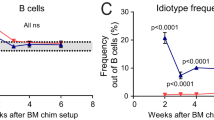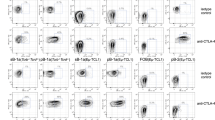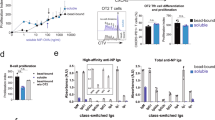Abstract
THE long-standing hypothesis1,2 that tolerance to self antigens is mediated by either elimination3–8 or functional inactivation (anergy; refs 9-11) of self-reactive lymphocytes is now accepted, but little is known about the factors responsible for initiating one process rather than the other. In the B-cell lineage, tolerant self-reactive cells persist in the peripheral lymphoid organs of transgenic mice expressing lysozyme and anti-lysozyme immunoglobulin genes9, but are eliminated in similar transgenic mice expressing anti-major histocompatibility complex immunoglobulin genes8. By modifying the structure of the lysozyme transgene and the isotype of the anti-lysozyme immunoglobulin genes, we demonstrate here that induction of anergy or deletion is not due to differences in antibody affinity or isotype, but to recognition of monomeric or oligomeric soluble antigen versus highly multivalent membrane-bound antigen. Our findings indicate that the degree of receptor crosslinking can have qualitatively distinct signalling consequences for lymphocyte development.
This is a preview of subscription content, access via your institution
Access options
Subscribe to this journal
Receive 51 print issues and online access
$199.00 per year
only $3.90 per issue
Buy this article
- Purchase on Springer Link
- Instant access to full article PDF
Prices may be subject to local taxes which are calculated during checkout
Similar content being viewed by others
References
Burnet, F. M. The Clonal Selection Theory of Acquired Immunity (Vanderbilt University Press, Nashville, 1959).
Nossal, G. J. V. A. Rev. Immun. 1, 33–62 (1983).
Kappler, J. W., Roehm, N. & Marrack, P. Cell 49, 273–280 (1987).
Kappler, J. W., Staerz, U., White, J. & Marrack, P. C. Nature 332, 35–40 (1988).
MacDonald, H. R. et al. Nature 332, 40–45 (1988).
Kisielow, P., Blüthmann, H., Staerz, U. D., Steinmetz, M. & von Boehmer, H. Nature 333, 742–746 (1988).
Sha, W. C. et al. Nature 336, 73–76 (1988).
Nemazee, D. A. & Bürki, K. Nature 337, 562–566 (1989).
Goodnow, C. C. et al. Nature 334, 676–682 (1988).
Rammensee, H.-G., Kroschewski, R. & Frangoulis, B. Nature 339, 541–544 (1989).
Ramsdell, F., Lantz, T. & Fowlkes, B. J. Science 246, 1038–1041 (1989).
Morello, D., Moore, G., Salmon, A. M., Yaniv, M. & Babinet, C. EMBO J. 5, 1877–1883 (1986).
Goodnow, C. C. et al. in The Immune Response to Structurally Defined Proteins: the Lysozyme Model (eds Smith-Gill, S. & Sercarz, E.) 389–402 (Adenine, New York, 1989).
Forster, I., Vieira, P. & Rajewsky, K. Int. Immun. 1, 321–331 (1989).
Hardy, R. R., Carmack, C. E., Shinton, S. A., Kemp, J. D. & Hayakawa, K. J. exp. Med. 173, 1213–1225 (1991).
Wyllie, A. H., Kerr, J. F. R. & Currie, A. R. Int. Rev. Cytol. 68, 251–306 (1980).
Nemazee, D. & Buerki, K. Proc. natn. Acad. Sci. U.S.A. 86, 8039–8043 (1989).
Murphy, K. M., Heimberger, A. B. & Loh, D. Y. Science 250, 1720–1723 (1990).
Sidman, C. L. & Unanue, E. R. Nature 257, 149–151 (1975).
Raff, M. C. et al. J. exp. Med. 142, 1052–1064 (1975).
Klaus, G. G. B., Howard, J. G. & Feldmann, M. Br. med. Bull. 32, 141–146 (1976).
Dintzis, R. Z., Middleton, M. H. & Dintzis, H. M. J. Immun. 131, 2196–2203 (1983).
DeFranco, A. L. A. Rev. Cell Biol. 3, 143–178 (1987).
Cambier, J. C. & Ransom, J. T. A. Rev. Immun. 5, 175–199 (1987).
Harnett, M. M. & Klaus, G. G. B. Immun. Today 9, 315–320 (1988).
Gold, M. R., Law, D. A. & DeFranco, A. L. Nature 345, 810–813 (1990).
Campbell, M. A. & Sefton, B. M. EMBO J. 9, 2125–2131 (1990).
Brunswick, M., Samelson, L. E. & Mond, J. J. Proc. natn. Acad. Sci. U.S.A. 88, 1311–1314 (1991).
Reth, M. et al. Immun. Today 12, 196–201 (1991).
Smith-Gill, S. J., Mainhart, C. R., Lavoie, T. B., Rudikoff, S. & Potter, M. J. Immun. 132, 963–967 (1984).
Coffman, R. L. Immunol. Rev. 62, 5–23 (1982).
Schönrich, G. et al. Cell 65, 293–304 (1991).
Weiss, E. et al. EMBO J. 2, 453–462 (1983).
Gascoigne, N. R. J., Goodnow, C. C., Dudzik, K. I., Oi, V. T. & Davis, M. M. Proc. natn. Acad. Sci. U.S.A. 84, 2936–2940 (1987).
Goodnow, C. C., Crosbie, J., Jorgensen, H., Brink, R. A. & Basten, A. Nature 342, 385–391 (1989).
Stall, A. M. et al. Proc. natn. Acad. Sci. U.S.A. 85, 3546–3550 (1988).
Parks, D. R., Lanier, L. L. & Herzenberg, L. A. in The Handbook of Experimental Immunology Vol. 1 (eds Weir, D. M., Herzenberg, L. A., Blackwell, C. C. & Herzenberg, L. A.) 29.1–29.21 (Blackwell, Edinburgh, 1986).
Author information
Authors and Affiliations
Rights and permissions
About this article
Cite this article
Hartley, S., Crosbie, J., Brink, R. et al. Elimination from peripheral lymphoid tissues of self-reactive B lymphocytes recognizing membrane-bound antigens. Nature 353, 765–769 (1991). https://doi.org/10.1038/353765a0
Received:
Accepted:
Issue Date:
DOI: https://doi.org/10.1038/353765a0
Comments
By submitting a comment you agree to abide by our Terms and Community Guidelines. If you find something abusive or that does not comply with our terms or guidelines please flag it as inappropriate.



